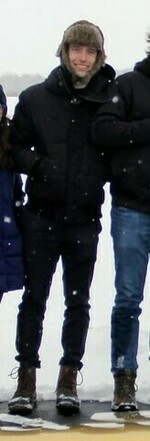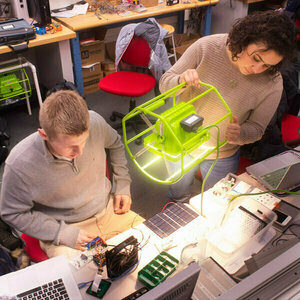If you have an interest in the design and operation of aircraft and space vehicles, you may find a home in the aerospace engineering program at Notre Dame. The two students below did. They came to the major with different interests, but what unites all aerospace students is their desire to design, build, and see their creations come to life.
Below, they share what they love about the program and talk about some of the amazing opportunities they've had as aerospace engineering majors.

Nandini Sadagopan '23
Major(s): Aerospace engineering, physics
Why did you choose to major in aerospace engineering?
For as long as I can remember, it has been my dream to work in the space industry—specifically space exploration. I’m a very tactile person, so I was drawn to engineering, and specifically kinds of engineering that would allow me to build physical systems. Aerospace engineering fit that niche perfectly!
Were you always interested in topics related to this major?
Yes! Like a lot of people who choose aerospace, I was drawn to the discipline really young. For me, it started when I visited NASA Johnson [Space Center] in Houston and saw a space shuttle in person for the first time when I was about six. Being that close to an engineering marvel really brought home for me what humanity is capable of when we orient ourselves towards collective wonder and exploration for its own sake. I’ve never outgrown the feeling of pride and awe that I felt seeing that shuttle, and I hope I never do.
So far, what has been your favorite class in the program and why?
While I was studying abroad in Rome over the summer after my first year, I was able to take a class called Quantum Engineering: Past, Present, and Future, which was an aerospace engineering course taught by a physics professor. In the class, we learned the basics of quantum mechanics as well as applications to current and future technology. This class was the perfect blend of practical engineering and beautiful and complex theory, and it actually piqued my interest in the intersection of theoretical physics and engineering, inspiring me to add a physics major!
Have you conducted any related research or independent study?
Yes! I’ve been working with Dr. Jonathan Crass in the physics department since my sophomore year. His work is focused on building an instrument that can detect earthlike exoplanets. The system needs to be kept very cold (around 80K) and needs to be precisely controlled (to around 1 mK). My job is to help design the thermal system to meet these requirements by running simulations, designing thermal interfaces, and building in our clean room.
What makes the aerospace program at Notre Dame stand out among programs like it at other schools?
Notre Dame has so many opportunities to practice the skills you learn in the classroom and apply them to really cool engineering problems. From design teams like Design Build Fly, IrishSat, and Rocketry Team, to research with faculty to class projects to designing and machining personal projects in the Engineering Innovation Hub, there’s always a way to ignite your passion and find your niche in aerospace.
Do you have any advice for prospective students who are considering a major in aerospace engineering?
The biggest determining factor in whether you finish the Aero program is not how smart you are but how resilient and persistent you are. The courses are difficult and not all of them will be your favorite subject (that’s how you become a well-rounded engineer), but I promise you have the capability to do it. Keep your why in mind, join a design team, and find some study buddies and you’ll do great. Ad Astra!
What are your career plans/post-graduation plans?
I’m planning on going to grad school to get a Ph.D. in instrumentation for planetary science exploration!

Brendan Kane '22
Major: Aerospace engineering
Why did you choose to major in aerospace engineering?
I’ve always been super interested in the aerospace field. I still remember visiting the NASA Kennedy Space Center as a kid and being so fascinated with the experience that I immediately started “designing” (sketching a pretty unrealistic schematic) of a spacecraft on the drive home. Because I’ve always been good at STEM topics, and because I had this prior interest, it was only natural for me to pursue aerospace engineering.
Were you always interested in topics related to this major?
Yes! I’ve been into NASA and rockets since I was a kid. I came to Notre Dame with the intention of fostering these interests more formally through my aerospace engineering degree. Notre Dame’s aerospace department is, I should note, more heavily focused on in-atmosphere aircraft (planes) than satellites/rockets. I initially was somewhat disappointed by this, but honestly, having gone through a majority of the program, I like planes much better than rockets now. They’re just so much more interesting!
So far, what has been your favorite class in the program and why?
My favorite class has definitely been Flight Mechanics and Intro to Design. In this course, each student designs their own conceptual aircraft from the ground up, first considering general characteristics and design drivers, then getting into super detailed topics like wing geometry, fuselage shape and contours, lift-enhancement devices, etc. It’s a great course that really brings together all the aero knowledge that students learn in their first, sophomore, and junior year. I particularly enjoyed it because it really instills an “instinct” for designing aircraft—I finished the class able to run the raw calculations necessary to support my design, but I also gained a sense of the art that goes into designing a plane.
Have you conducted any related research or independent study?
Yes, during my time at Notre Dame I have been fortunate enough to be able to work with Professor Hirotaka Sakaue in his lab group up at White Field (the primary aerospace engineering lab on campus—it has a lot of wind tunnels). Professor Sakaue is both a great professor and mentor. I have really gained a lot from being able to work with him. And it wasn’t even that difficult to get involved with his work! He actually reached out to me after I took his Introduction to Aeronautics course to see if I would be interested in working in his lab.
During my first year in the lab I worked under a graduate student advisor to create samples of “luminescent ice,” a type of ice that changes color based on experienced temperature gradients (thus making it a useful temporospatial temperature sensor). I continued to work on this project in subsequent years, but also began conducting independent research on thrust vectoring techniques. Professor Sakaue has always been available to chat about my work and offer advice.
What makes the aerospace program at Notre Dame stand out among programs like it at other schools?
The Notre Dame aerospace program stands out in the sheer number of opportunities available to students that wish to build on their aerospace knowledge outside of the classroom. Notre Dame is a premier aerospace research university. Almost all of the aerospace professors lead lab groups working on really impressive projects for very influential members of the aerospace community.
Almost all of these aerospace professors are also willing to accept undergraduate students into their lab environments—these sorts of opportunities (like the opportunity to work in the same lab where tests are run using a Mach 6 wind tunnel) are not present at most universities.
If a student isn’t interested in research, there is a very active community of aerospace-based clubs. I am a sub-lead of the aero squad on Design/Build/Fly, a Boeing-sponsored club that creates a competition RC plane over the course of the academic year. Students more interested in space topics can join the Notre Dame Rocketry Team or IrishSat. Being a member of one of these clubs is a lot of work, but it’s fun work—the work of being an engineer and tackling/solving difficult design challenges.
Do you have any advice for prospective students who are considering a major in aerospace engineering?
My advice would be: Understand what you’re getting into! I didn’t really think too hard about how difficult being an aerospace engineering student would be before I got to campus, but I learned pretty quickly. This is a hard major, and it requires a lot of effort. All the aeros in my year have formed a tight-knit group after going through so many tough classes together. I value that bond, but it is a bond that was forged over the course of innumerable late nights, difficult exams, and massive projects. If you’re ready to apply yourself and do the work, the skills and knowledge this major can impart are incredibly rewarding.
What are your career plans/post-graduation plans?
Last semester, I accepted a post-graduation position with Boeing Commercial Airplanes. I will be working up in Seattle with their Aerodynamic Performance division as an Aerodynamics Engineer. This position is right up my alley and I’m super excited for it!

Learn More
Explore engineering at Notre Dame.